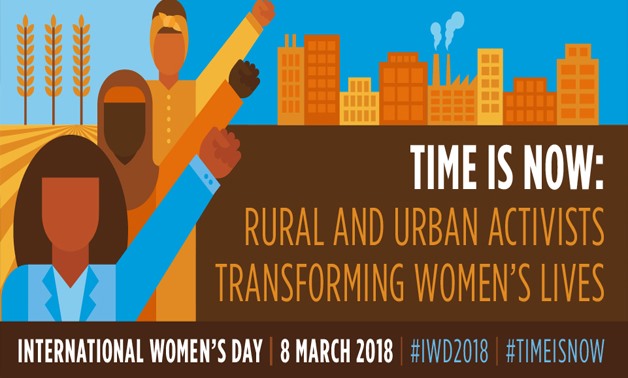
International Women’s Day 2018 theme and main banner - UNWOMEN
On the occasion of the International Women’s Day (IWD), the United Nations organization dedicated to gender equality and the empowerment of women (UNWOMEN) announced that this year’s theme is “Time is Now: Rural and urban activists transforming women’s lives.”
The 2018 theme spots the light on the importance of empowering and voicing the needs of rural women across the globe. It highlights the critical role these women and girls play to ensure both food and social security for their families and communities. It also discusses the multiple forms of discrimination and violence that they face, particularly women farmers and agricultural workers, indigenous women, tribal women, fisherwomen and informal women workers.
Rural women and girls have limited access to and control on land and productive resources, they do most of the unpaid and unrecognized household care, they lack access to information and communication technologies, they suffer from legislations that limit their ability to take loans and achieve economic independence, and they are heavily impacted by poor infrastructure, unregulated migration and climate disasters resulting from climate change. This vulnerability is further exacerbated by intersecting inequalities against young women and girls, older women, heads of households, women with disabilities, migrants, refugees and internally displaced women. The status of rural women and girls becomes more vulnerable in contexts of displacement, armed conflict,
militarization and extremism as they create greater opportunities for kidnappings and sexual exploitation.
The UNWOMEN published the following facts on the status of rural women and the challenges they face in labor market, education and health building on several reports published by U.N. organizations and the U.N. Secretary General’s report: Challenges and opportunities in achieving gender equality and the empowerment of rural women and girls.
The share of women working in agriculture by region

Photo credit - UNWOMEN
According to UNWOMEN, agriculture is the main employment sector for women in developing countries and rural areas. This sector falls within the informal economy leading to little social protection and labor rights. Therefore, these women endure lower life standards, poorer wages and health conditions, limited access to social services, restricted mobility and a lack of voice and agency.
Only 13 percent of agricultural landholders are women

Photo credit - UNWOMEN
This fact leads to less income security, less decision making power in private and public spaces, inability to access credit to start a business or improve agricultural productivity.
A rural woman is 38 percent less likely to give birth with a health care worker than an urban woman in low-income countries

Photo credit - UNWOMEN
This leads to increased chances of life-threatening complications, severe bleeding, infection and maternal mortality.
Rural women and girls are often responsible for fetching water

Photo credit - UNWOMEN
Sixty eight percent of the population in urban areas has access to safe and clean drinking water compared to 20 percent in rural areas. This situation increases the burden on women and girls to fetch clean water for the family, leading to barriers to education and employment, more unpaid domestic work, higher risk of maternal mortality and violence as well as psychosocial stress.
A rural girl is two times more likely to get married as a child compared to urban girls

Photo credit - UNWOMEN
Child brides face barriers to education and employment, greater risk for intimate partner violence and domestic violence, early pregnancy that can lead to maternal complications and vulnerability to STDs including HIV.
More than half of all poor rural women lack basic literacy skills

Photo credit - UNWOMEN
This leads to lower-quality jobs and decreased personal well-being.
The majority of rural women and girls are not connected to the internet

Photo credit - UNWOMEN
This leads to limited opportunities to learn new skills and obtain information and knowledge as well as limited economic opportunities.
The UNWOMEN also suggests a group of recommendations to empower rural women and girls including creating decent work opportunities, establishing social protection mechanisms, providing clean waterand sanitation, combating harmful practices and increasing women’s resilience to climate change.







Comments
Leave a Comment